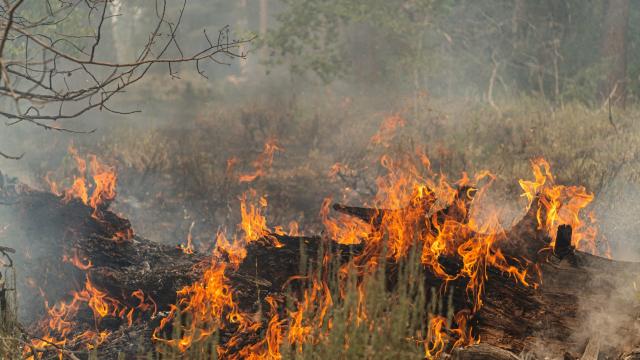Eighty-six large forest fires are burning across 12 states. Among the trees they’re torching are ones being used as carbon credits, showing the danger of relying on forests to offset emissions elsewhere.
The Bootleg Fire is the nation’s largest wildfire of the season and has spread across more than 400,000 acres of Oregon and California. It has torched 24% of one such project known as Klamath East — a 161,874.40 ha forest owned and operated by the Green Diamond Resource Company — according to analyses by CarbonPlan, a nonprofit research firm that specialises in investigating carbon removal programs.
Two other blazes, the Summit Creek and Shoal Creek Fires, are currently tearing through an offset project in eastern Washington state that is operated by BP (yes, that BP) on the Colville Indian Reservation. Four per cent of the project has burned down so far, and the flames are expected to spread in the coming days as temperatures rise again.
“The Summit Trail Fire, in particular, is uncontained, so we’ll be watching that closely in the coming days,” Joe Hamman, technology director at CarbonPlan, said.
On Tuesday, CarbonPlan will release a project mapping out fire risk to forest offsets across the West. But the early returns this wildfire season aren’t good, and more forests used as a climate buffer could still burn.
Offset projects allow polluting corporations to purchase credits for carbon sequestered by those projects so that corporations can continue polluting. In the U.S., the majority of offsets are based on reforestation. All kinds of highly polluting businesses, from cryptocurrency businesses to energy giants, favour these schemes. Yet the issues with these forest offset programs are manifold. Globally, projects have displaced Indigenous populations who use forests, to make space to plant trees. They also do not undo pollution and can, in fact, lead to increased emissions.
California began its forest offsets program in 2013 and it now constitutes a major part the state’s strategy for reducing climate pollution. Yet an April report from CarbonPlan, ProPublica, and MIT Technology Review found that because of crucial mathematical errors in accounting, the scheme has actually increased greenhouse gas emissions. The authors estimate that nearly 30% of the offsets in the program are overvalued for the amount of carbon they sequester.
Wildfires take that problem from bad to worse. When they burn, trees release all the carbon they’ve removed from the atmosphere over their lifetimes.
“So now, if you start thinking about forest offset projects as areas that might burn, that means they’re also sources of emissions,” said Oriana Chegwidden, a climate scientist at CarbonPlan.
Regulations for California’s carbon credit programs anticipate that fires will do some damage. Project owners are thereby required to set aside some fraction of a project’s credits in buffer pools, which they can tap into if land burns up, or is lost for other reasons such as plant disease or insect outbreaks. These pools essentially serve as insurance programs.
But as fire seasons become longer and more severe due to the climate crisis, that percentage will likely not be enough. For instance, the California Air Resources Board, which governs the state’s offset program, ensures that every project sets aside between 10 and 20% to such pools. That threshold doesn’t seem to have yet been crossed for any projects this year, but as the season continues, that could change.
“What we’re seeing is that the buffer pool is very likely undersized, and that increases in fire risk that we’re starting to experience, especially in the West, are seeming likely to overwhelm the buffer pool within the 100-year window that it was designed for,” said Hamman.
If this doesn’t happen this year, it almost certainly will in the future as climate breakdown intensifies. Recent studies have found that the Amazon rainforest recently reached a tipping point and is now producing more greenhouse gas than it is sequestering due to fires. As the climate crisis continues, forests in the West could meet the same fate. A story published on Tuesday in MIT Technology Review shows that the fires this year alone have already released enough carbon dioxide to “wipe out more than half of the region’s pandemic-driven emissions reductions last year.”
Chegwidden co-authored a pre-print paper released earlier this year that used modelling coupled with fire and forest data to show what fire risk might look like in the future. The results show that in every single future scenario modelled, fire risk increased substantially. Even with urgent action, some increased risk is likely unavoidable. But that’s better than the prospect of doing nothing.
“If we were to start mitigating emissions, whether by reducing emissions or starting to engage in large scale carbon removal, we would see decreases in fire risk. The low emission scenarios do show substantially lower fire risk than the high emissions scenarios,” she said. “But regardless, for the next few decades, no matter what we do, fire risk will likely increase.
One solution would be to increase the size of these mandatory pools for forest offsets. But perhaps a better one would be to stop relying on these programs altogether given their troubled history and challenges a hotter future poses to them.
“There’s a theoretical basis for which you might find yourself using forest offsets as a climate solution,” said Hammon. “But wherever we look, whether it’s to fire risk, or to the way we do crediting based on baselines of forest carbon, we’re finding that programs have been underdesigned or poorly designed to address some of these concerns. It definitely brings into question the quality of these as a potential climate solution.”
